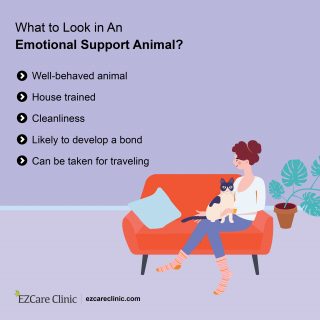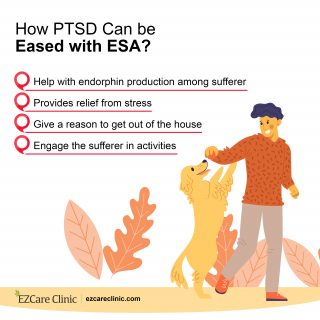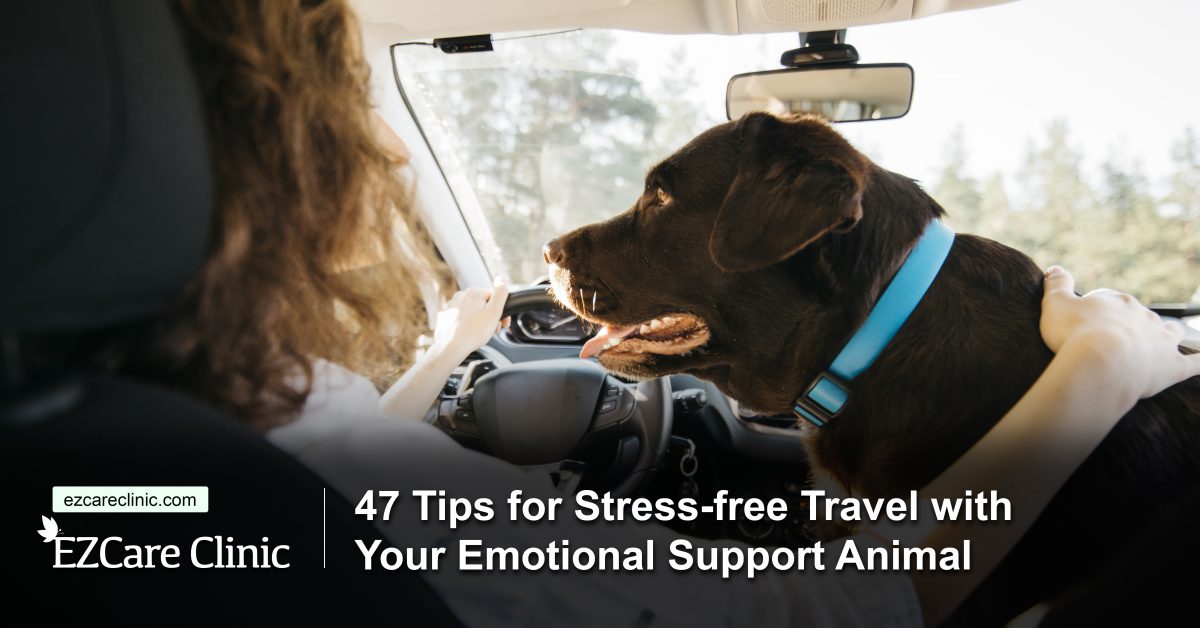Discover stress-free ways to travel with your emotional support animal. You can take your pet anywhere with you, including planes and hotels, and not have to pay extra fees. You can hang out with your emotional support animal even at “no pets allowed places.” Start by getting the EzCare ESA letter, and then empower yourself with the right information.
Click the button below to get an ESA Letter for your Emotional Support Animal easily!
What is an emotional support animal?
Put simply. Emotional support animals are therapeutic pets. The ESA concept is a psychology and psychotherapy model that has proven effective against many conditions. You can have an ESA as a cat, a ferret, or any other animal that you feel attached to.
Emotional support animals help with anxiety and depression. They provide unconditional love and can help the owner to deal with:
- Stress and panic attacks
- PTSD
- Suicidal thoughts and behaviors
- Panic attacks
- Bipolar disorder
- Substance abuse
- Anxiety and phobias
- Eating disorders and sleeping disorders

How Emotional Support Animal Helps with Anxiety?
Emotional Support Animal Letters
The ESA letter is your license to live with, travel with, and use a pet as your psychological therapy. Qualifying conditions include the above listed and many others. The animal can be your main ‘prescription,’ or it can complement other forms of treatment.
The therapy pet certification is the first thing you should think about when you intend to travel with your animal. It must be written and signed by a mental health professional on the official letterhead. It should contain the health practitioner’s license number and disclose the purpose of issuance, among other details.
Where Can you Take an Emotional Support Animal?
Anywhere—the ESA letter ensures that owners face no restrictions when they travel with such animals. The certification further qualifies you for:
- Unrestricted housing even on properties with a no-pet policy
- Accommodation any hotel even in those that don’t allow pets
- Stay in hotels or apartments without paying pet fees
- Flights with your pet without having to part with wit pet-fare
Don’t back down or interrupt therapy. The law is on your side.
It’s illegal for landlords, hotels, airlines, or anyone to try to separate you from your therapeutic pet. You don’t have to disclose anything when you go anywhere. Don’t tell them about your condition. Don’t reveal anything about your animal or the therapy. Just produce the ESA certificate.
The accommodations, as mentioned before, apply whether you are at work, at school, in your home city, or a different corner of the world. Those that contravene the provisions limit your right to have your animal with you. They will be liable for massive fines when you press charges.
Back on the Road: How to Travel Stress-free with an Emotional Support Animal
The unique bond you have with your ESA is how the magic of the therapy works. Traveling with your animal, therefore, needs to be a stress-free experience: Anything else might accelerate the symptoms of your anxiety and related emotion states. Here is how to get it right:
Before the trip
1. Take time to plan your journey
The first thing to remember is that unlike service animals, emotional support animals are not trained. They are a comfort to have around, but most a time, they don’t know how to behave. They don’t know what cues to follow from the owner to offer the best support. But still try to be the best no matter what. Hence, best emotional support dogs among the best breeds are known for this.
You may find, therefore, that the roles are reversed. That is when your animal gets too anxious on the flight or around people, and you become the emotional support provider.
Other possible challenges:
- How and where they feed
- Where they ‘do their business.’
- How to deal with motion sickness
- How to act when they get frantic
- To leash or not to leash?
- Dealing with a sick pet onboard
- Dealing with airline travel policies
- The vaccination requirements in your destination
2. Choose a direct flight or train routes with many stops
Changing planes is stressful. It is worse when you are traveling with a pet. Choose a direct flight to minimize lengthy procedures that might get you and the pet fatigued and anxious. On the other hand, train routes with many stops are recommended when traveling with companion animals. They give you breaks for feeding, rehydrating, and walking your pet.
3. Get and submit ESA documentation
Most airlines and cruise lines require that you submit your ESA document two weeks in advance. In the recent past, there have been many untrustworthy people looking to take advantage of the ESA accommodations for people like you. By booking your flight and submitting your ESA certificate earlier, you help the airline to prove authenticity and prepare adequately for your travel.
4. Train your pet and look forward to an enjoyable trip
How long can your companion pet go without eating or relieving themselves? Can they stay calm in the presence of strangers or at take-off and landing? How do they react in the event of loud noise? Do some tests at home, in the car, and in public spaces to prepare your animal. Teach them to stay calm, follow your cues, and trust you.

What to Look in An Emotional Support Animal?
5. A visit to the vet is good for the pet and you
One of the things that they will check before allowing your pet to disembark is recent vaccination history. That largely depends on your destination, though, and shouldn’t be grounds to infringe your ESA rights. To be on the safe side, make that visit to the vet.
Most countries require that pets get an anti-rabies shot at least 21 days before departure. The vaccine has a validity of one year. So if 12 months haven’t elapsed since the last one, you are good to go.
You may also need to travel with anti-flea medication and special food. Get enough supplies from your vet before you depart. The right amount of pet food and medicine should last through the trip and several days beyond.
Apart from vaccinations and medications, you might want to inquire about stress relaxing solutions. The vet can advise on certain medicines to keep your pet calm through the trip. Sedation is a brilliant idea for animals that are prone to anxiety.
6. The microchip technology helps never to lose your pet
You might also be required to microchip your animal to help with identification if they get lost on the plane, ship, or train. There may be other travelers with dogs and cats, some of them with close resemblance to yours. A microchip technologizes the identification process by linking back to the database of unique information about your pet.
7. Pack all essentials and don’t forget the emergency aid kit
Done packing for yourself? Proper. Now you have to get down to what your ESA needs for the journey. Just like you, they need something to keep warm, something to nibble on when hunger pangs strike and a first aid kit. How humanlike!
Ensure you pack everything right, or your trip could go awry over the small stuff. Depending on the length of your trip, you might need:
- A few treats
- Collar and leash
- A paper towel
- Poop bags
- Water bottle
- Water bowl
- First Aid kit
A pet-friendly carrier will likely have these and other necessities onboard. Many are capitalizing on this as a marketing opportunity, and that means fewer headaches for you. Do extensive research and choose well. You may also need blankets, swimming vests, rain jackets, and collapsible water bowls.
8. Exercise your pet before departure
Whether you are traveling by air, train, or car, it’s wise to do it with a relaxed animal. Take them on a walk so they can spend all their excess energy. That will keep them from getting hyper when the plane takes off, or when you start the car.
Book an appointment to get your ESA letter!
9. Choose a cozy and spacious crate for Fido
You can fly without a crate for your ESA animal. That’s the essence of emotional support—they need to be with you and not in some crated cabins. Most airlines allow pet owners with an ESA letter to sit with their animals. You let the pet sit on your lap.
Things are different on the road when you are the one behind the wheels. You must ensure that your furry/feathery friend does not jump around in the car. That could drastically interfere with your ability to keep your eyes on the road. You must, therefore, find a comfortable crate for them.
Some crates are like cages. They keep the animal mercilessly restrained with little room to move around. Others overheat and make the animal suffer in the scorching temperatures of the summer. Choose something cozy, spacious, and well ventilated for your companion animal.
At Check-In
10. Keep your buddy relaxed and comfy at check-in
Your rehearsals at home helped to familiarize your pet with crowded situations. Keep a watchful eye on their temperament. Keep them calm using the specific cues from the training. Do not bring your pets close to where police dogs are operating. That could trigger up their anxieties.
Visit the pet-relief areas before the security check. Most airports have a pet relief area where you can take your animal to ‘do their business.” That should help to guarantee a smooth screening process even when there is a long queue.
11. Follow the requirements at the security checkpoint
Your pet needs to be screened at the security checkpoint before you can board with it. Bring it along, either carrying it or leading it on a leash. Do not let them through the x-ray tunnel for scanning luggage. Pet screening can be done when they are outside or within the carrier. After checking, you are to return with your pet to the re-composure area away from other passengers and security.
12. Board first or board last
Request early or last boarding, so the staff gets enough time to check your paperwork. Otherwise, you might end up keeping people in line at check-in. You also want exposure for your pets to crowds and congested queues.

How PTSD Can be Eased with ESA?
On the plane
13. Sit with your pet close with you
You can carry them on your lap or place them in the space under the seat in front of you. The Department of Transportation allows that for service and emotional dogs. Don’t let them get relegated to the cargo area.
14. Be compassionate
You might find yourself sitting next to a passenger with allergies. Switch seats if that helps to keep fellow travelers comfortable. You may similarly be asked to change positions if you are seated close to the emergency exit. Be ready to make small compromises.
15. Positive reinforcement works wonders
After take-off, it’s easy to keep your pet relaxed and happy in your arms or by your side. Try the positive reinforcement technique. Issue a treat for good behavior and hold back when they get jumpy. Experts recommend limiting food and water on flight.
In the Car
16. Keep your pet safe in carriers at the back
If you are traveling by car, a pet carrier is a must-have. Your cats and dogs should ideally be in the carrier and fastened in the back seat. Be sure to get cozy carriers for your ESA as earlier mentioned, or the animal will be restless for the entire journey. Restrain the carrier with a seat belt, so the animal doesn’t get hurt when you get on a bumpy road, and the crate begins to bounce.
17. Don’t let them stick out their heads
It’s unsafe. Your animal could get nauseated or get hit by debris. For the same reasons, it’s advisable not to transport them in an open truck or on the roof of a van.
18. Have some downtime for snacks and potty
Your pet may need a break from the crate, especially if it’s a long trip. The animal also needs to feed and relieve themselves. Give them that break, but keep a close eye on them. Don’t let them wander without a leash.
Book an appointment to get an ESA letter from licensed healthcare professionals!
19. Don’t leave them with no one in the car
During those breaks, you shouldn’t leave your pet alone for long. It’s illegal to leave an animal in a parked vehicle. It’s inhumane—the temperatures could rise or drop to extreme levels causing severe health issues to your animal. A maximum of five minutes should be the longest time you leave them unattended in the car.
On a Cruise Ship
Service and emotional support animals are accepted on cruise ships. The ESA letter permits you to step into any ship with your animal. Even so, not all ships have pet-friendly facilities and services. Research the best pet-friendly cruises before you travel.
20. Don’t lose sight of your pet
Don’t let your pets out of sight. Go with them everywhere, including dining areas and other public areas. For the comfort of others, consider having bigger pets on a leash or harness. Don’t let them get into pools or spas.
21. Bring enough food and restock at ports
Cruises are long journeys. While the ESA certificate mandates that cruise lines take you on board with your pet, they don’t require the companies to provide food, bowls, or toys. Bring enough food, therefore, on the day of departure, and consider restocking at every port.
22. Disembark with your pet if the laws allow
Don’t leave your pet on the ship when you get off at the ports. If you must leave them on board, make arrangements with a friend to look after them when you are not around. Please note that the ship’s employees are not required to take care of pets.
23. Get updated on each of your destinations and pet laws
You may be free to disembark with your animal at specific ports, but not all. Some countries require quarantine of all animals on arrival. Please research the rules that apply to the ship’s ports of call and make plans in advance.
24. Keep the tag on Fido, so you don’t lose him
Cruise ships are big, and people are increasingly traveling with service animals and emotional support pets. Please have yours tagged for the sake of easy identification if they start to play hide and seek with you. Don’t remove the tag whatsoever.

Top 7 Dog Breeds for ESA
25. Clean up their poo
Clean and dispose of your pet’s waste responsibly. The comfort and health of your fellow passengers depend on it.
On a Train
The National Railroad Passenger Corporation allows pets on all lines, but don’t forget to carry your ESA letter. Other persons can bring their pets, but they will be required to pay $26 as pet fare. Your ESA letter will exempt you from the fees.
26. Keep the pet snug and safe on a leash or harness
Your pet can get overexcited or frightened during a train ride. Consider keeping them on a leash for easier control. Even so, consider the comfort and safety of your emotional support animal when using restraints. Treats and positive reinforcement could work better.
27. The floor could be much safer
It is easier to keep your animal in control and reduce their risk for motion sickness if they sit on the floor. This is also for the comfort of fellow passengers who may have allergies or general dislike for pets. Lay down some blankets or anything similar for your pet to sit comfortably.
28. Play with Buddy at stop stations
Your pet will need a break from the long hours of sitting. Get them off the train for a short walk at station stops. Don’t go too far, though. You might get left behind if you miss the departure time. Notify the conductor in advance.
Register your cat or dog as ESA now by clicking the button below!
29. Keep the pet hydrated for the rest of the trip
Hopefully, you packed plenty of water and snacks. It’s not advisable to feed your pet on transit, but that’s what stops are for. Keep your animal well hydrated.
Taxis and Cabs
You might need a taxi, cab or even a bus to get to your destination after the airport or train station. The same tips apply—keep your animal comfortable and stay in control. Things should work out well if you have a crate handy.
30. Know the pet policies for your cab company
Some drivers will let your pet sit with you. Others will require that they sit on the floor. Before you get into a cab, ask about the cab’s pet policies. Do the same for buses and rental cars.
Get an authentic ESA letter from EzCare Clinic!
In Hotels
31. Choose a pet-friendly hotel
You can find accommodation in any hotel with your ESA letter. But for the sake of your pet’s comfort and your sanity, please choose a pet-friendly hotel. Now more than ever, forward-thinking hotel brands are offering pet-friendly services and accommodation that makes it easier for pet parents like you. These hotels will have pet bowls, toys, food, and designated pet relief areas.
32. The best rooms are on the ground floor
Pets can get uneasy on elevators because of both the ride and people. The ground floor helps to get them in and out of the hotel with no trouble.
33. Give the animal a frequent bath
Pets may drag mud and dirt back into the hotel. If that stains the hotel’s carpets and lines, you may have to pay for cleaning costs. So don’t forget to wipe their feet and give them a regular bath.
34. Be the best companion for your pet
Don’t leave your cats and dogs unattended in a hotel room for long. They might start to bark and whine and make it uncomfortable for other guests. Keep your pet comfortable and ensure hotel employees are safe when they do housekeeping with your pet in the room.
35. Turn on the TV when you leave the room
You might have to leave your pet in the room for a short time, though. Turn on the TV to keep them engaged. It will ensure that they don’t pick up noises/ scents from the outside and get anxious.
36. Find a pet-sitter service and get some rest
Sometimes it’s hard to take your pet everywhere with you. Some pet-friendly hotels provide pet-sitter services. These might take the stress off your shoulders for some time, allowing you to get some sun on the beach or let your hair down at a pub.
37. Feed, exercise and play with them
Pets are creatures of habit. They will need feeding and exercise at the exact times as you do at home. Don’t forget these routines, or your pet will be one unhappy and grumpy companion.
38. Do something fun together
Your pet has feelings too. They need relaxation as you do, so don’t leave them behind when you head to the beach, the mountains or the forests unless it’s necessary. Just ensure to bring a leash, some water, and enough treats.

Best ESA Cat Breeds
At an Airbnb
39. Communicate in advance, don’t sneak them in
Notify the owner that you intend to stay with your pet for psychotherapy reasons. This information should be part of what you include when booking the rental. It helps the owner to prepare in advance or suggest measures for the safety and comfort of your animal and you.
40. Keep Fido on his best behavior
Follow the pet stay policies at home. If pets should not be allowed on furniture, make them comfortable on the floor. Don’t let your animal wander alone on the property. Use your feeding bowls and clean up after them.
41. Get contacts of a vet and pet food store nearby
You need to be ready to replenish their food or get them medication when they need it. Ask the owner for recommendations or search online. You may also find that the rental home you have chosen provides so little in terms of pet comforts. You might need to buy supplies such as bowls and blankets when you get there.
42. Reduce the noise
Even pet-friendly Airbnbs and vacation rentals get visitors without pets. If your dog barks late into the night, that’s bound to stir trouble with your neighbors. You might get kicked out, so watch out.
Remember the behavior patterns of your pets and what gets them agitated, excited, or anxious. Remove those trigger factors. For instance, keep your dog from the windows if he gets too excited looking at people or birds.
43. Keep their diet consistent
On an extended vacation, you are more likely to feed your pet new kinds of food. Watch out, for that could be problematic. You are free to explore different cuisines for yourself, but keep your pet’s diet consistent. It helps to minimize sickness and stomach upsets.
Dry foods are recommendable during trips. They are easier to manage. But if your pet is used to canned or fresh food, then don’t change the diet. Find out where you can source them in your new destination if supplies run low.
Get an ESA Letter to travel easily with your emotional support animal!
On Tours and Trips
44. Be grateful to have a travel companion
The main reason why you are traveling with your furry or feathery buddy is the significant role they play in your life. They keep you centered. They are your stress-busters and give you unconditional love. So be grateful and give back some of that love. Get them pampered.
45. Take your time, don’t rush
Have a lighter itinerary that accommodates both you and your pet. Take time to enjoy every minute of the special moments outdoors on hike trails or the beach. Keep your bond with your animal strong and always have them close with you for when you need them.
46. Do what you love to do
Your trip should be relaxing and enjoyable. Find activities that lower you and make you feel alive. Find an activity that gets your pet excited as well.
47. Enjoy your trip
Enjoy your trip with your precious emotional support animal cat or dog. It gave you a reason to get out of your bed and explore the world.
If you qualify for an Emotional Support Animal, get your ESA letter today!
The take-home message
Traveling with pets is fun. It’s even more meaningful if they are emotional support animals that play a role in your healing and wellness. Use the above tips to have a safe and memorable journey wherever the road of life takes you.
Get yourself ESA letter from licensed professionals to travel without any hassle with your
To travel around with your emotional support system, get your ESA letter from EzCare Clinic’s licensed healthcare professionals.

